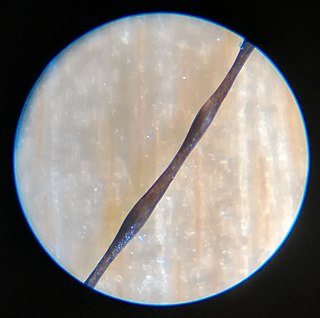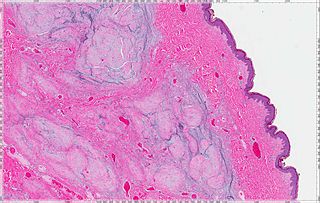Related Research Articles

Alopecia areata, also known as spot baldness, is a condition in which hair is lost from some or all areas of the body. It often results in a few bald spots on the scalp, each about the size of a coin. Psychological stress and illness are possible factors in bringing on alopecia areata in individuals at risk, but in most cases there is no obvious trigger. People are generally otherwise healthy. In a few cases, all the hair on the scalp is lost, or all body hair is lost. Hair loss can be permanent, or temporary.

Lichen planus (LP) is a chronic inflammatory and autoimmune disease that affects the skin, nails, hair, and mucous membranes. It is not an actual lichen, but is named for its appearance. It is characterized by polygonal, flat-topped, violaceous papules and plaques with overlying, reticulated, fine white scale, commonly affecting dorsal hands, flexural wrists and forearms, trunk, anterior lower legs and oral mucosa. The hue may be gray-brown in people with darker skin. Although there is a broad clinical range of LP manifestations, the skin and oral cavity remain as the major sites of involvement. The cause is unknown, but it is thought to be the result of an autoimmune process with an unknown initial trigger. There is no cure, but many different medications and procedures have been used in efforts to control the symptoms.

Telogen effluvium is a scalp disorder characterized by the thinning or shedding of hair resulting from the early entry of hair in the telogen phase. It is in this phase that telogen hairs begin to shed at an increased rate, where normally the approximate rate of hair loss is 125 hairs per day.

Alopecia universalis(AU), also known as alopecia areata universalis, is a medical condition involving the loss of all body hair, including eyebrows, eyelashes, chest hair, armpit hair, and pubic hair. It is the most severe form of alopecia areata (AA). People with the condition are usually healthy and have no other symptoms and a normal life expectancy.
Traction alopecia is a type of alopecia or hair loss caused by a chronic pulling force being applied to the hair. It commonly results from a person frequently wearing their hair in a particularly tight ponytail, pigtails, or braids with increased likelihood when hair is chemically relaxed as this compromises the hair shaft's tensile strength resulting in hair breakage. Traction alopecia causes a recession of the hairline due to chronic traction, which is characterized by a fringe along the marginal hairline on physical exam. Diagnosis is clinical and treatment directed at cessation of the chronic traction, while cosmeses, with surgical restoration is reserved for severe cases with scarring fibrosis.

Monilethrix is a rare autosomal dominant hair disease that results in short, fragile, broken hair that appears beaded. It comes from the Latin word for necklace (monile) and the Greek word for hair (thrix). Hair becomes brittle, and breaks off at the thinner parts between the beads. It appears as a thinning or baldness of hair and was first described in 1897 by Walter Smith

Hair diseases are illnesses that impact the persistence and regular growth of hair. Types of hair diseases include folliculitis, hirsutism, hypertrichosis, hypotrichosis (alopecia), Menkes kinky hair syndrome, monilethrix, and piedra.

Pili torti is characterized by short and brittle hairs that appear flattened and twisted when viewed through a microscope.

A cutaneous myxoma, or superficial angiomyxoma, consists of a multilobulated myxoid mass containing stellate or spindled fibroblasts with pools of mucin forming cleft-like spaces. There is often a proliferation of blood vessels and an inflammatory infiltrate. Staining is positive for vimentin, negative for cytokeratin and desmin, and variable for CD34, Factor VIIIa, SMA, MSA and S-100.
Erosive pustular dermatitis of the scalp presents with pustules, erosions, and crusts on the scalp of primarily older Caucasian females, and on biopsy, has a lymphoplasmacytic infiltrate with or without foreign body giant cells and pilosebaceous atrophy.
Tufted folliculitis presents with doll's hair-like bundling of follicular units, and is seen in a wide range of scarring conditions including chronic staphylococcal infection, chronic lupus erythematosus, lichen planopilaris, Graham-Little syndrome, folliculitis decalvans, acne keloidalis nuchae, immunobullous disorders, and dissecting cellulitis.
Pressure alopecia, also known as postoperative alopecia, and pressure-induced alopecia, occurs in adults after prolonged pressure on the scalp during general anesthesia, with the head fixed in one position, and may also occur in chronically ill persons after prolonged bed rest in one position that causes persistent pressure on one part of the scalp, all likely due to pressure-induced ischemia.
Alopecia mucinosa, also known as Follicular mucinosis, Mucinosis follicularis, Pinkus' follicular mucinosis, and Pinkus' follicular mucinosis–benign primary form, is a skin disorder that generally presents, but not exclusively, as erythematous plaques or flat patches without hair primarily on the scalp, neck and face. This can also be present on the body as a follicular mucinosis and may represent a systemic disease.
Antonella Tosti is an Italian physician and scientist with major contributions in the field of dermatology, including developing dermoscopy for the diagnosis and care of hair diseases, a world recognized expert in hair disorders. Her contributions to knowledge about nails include research about videodermoscopy of the hyponychium and the nail plate.

Triangular alopecia is hair loss that may be congenital but usually appears in childhood as a focal patch of loss that may be complete or leaving fine vellus hairs behind. Affected individuals are typically entirely healthy. Hair restoration surgery using follicular unit transplantation has been a successful treatment modality for TTA
Graham-Little syndrome or Graham Little-Piccardi-Lassueur syndrome is a cutaneous condition characterized by lichen planus-like skin lesions. It is named after Ernest Graham-Little.

Airbag dermatitis is skin irritation secondary to the deployment of airbags. The diagnosis of "air bag dermatitis" is relatively recent; the first case was reported in 1994.
SAHA syndrome, is a medical syndrome characterized by seborrhoea, acne, hirsutism and alopecia, and was first described in 1982. It is frequently associated with polycystic ovary syndrome, cystic mastitis, obesity, and infertility.
Alopecia neoplastica may present as a scarring alopecia, appearing anywhere on the scalp, and it has been described with cutaneous metastasis from breast, gastric, lung, renal and pancreatic carcinomas.
References
- ↑ Rapini, Ronald P.; Bolognia, Jean L.; Jorizzo, Joseph L. (2007). Dermatology: 2-Volume Set. St. Louis: Mosby. p. 1388. ISBN 978-1-4160-2999-1.